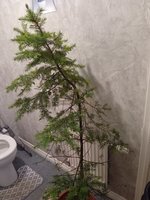Bonsai_beginner98
Seedling
Hey peeps, looking for some advice/guidance.
Been given what looks like a eastern red cedar (I'm not 100% sure, still a beginner) and she's abit on the tall side.
She's clearly a lovely looking tree and don't want to kill her. I'm leaning towards air layering the top section and leaving the rest to grow to become more a parent plant for cuttings, just wanted to know if it was even possible to do so?
After a little research, they are classed as a juniper so I believe it could be possible but being a beginner I don't want to kill such a big and healthy looking tree due to my lack of knowledge.
Any advice/guidance is much appreciated.
If it helps I'm in the West Midlands, UK.
Thanks for reading.
Been given what looks like a eastern red cedar (I'm not 100% sure, still a beginner) and she's abit on the tall side.
She's clearly a lovely looking tree and don't want to kill her. I'm leaning towards air layering the top section and leaving the rest to grow to become more a parent plant for cuttings, just wanted to know if it was even possible to do so?
After a little research, they are classed as a juniper so I believe it could be possible but being a beginner I don't want to kill such a big and healthy looking tree due to my lack of knowledge.
Any advice/guidance is much appreciated.
If it helps I'm in the West Midlands, UK.
Thanks for reading.


